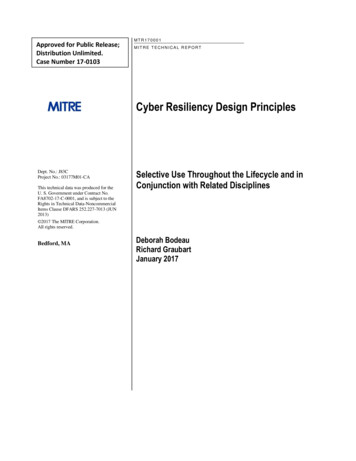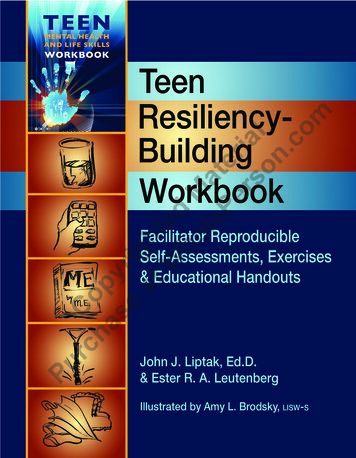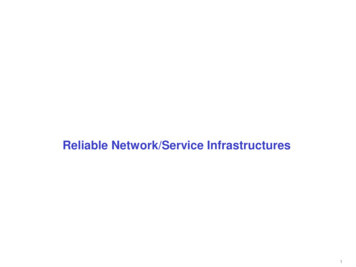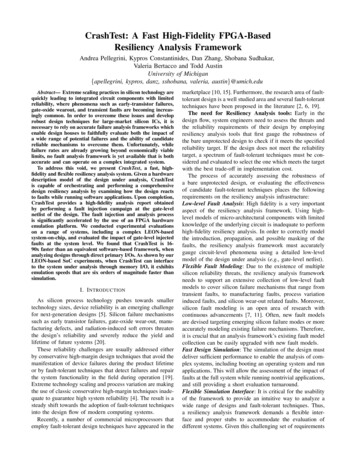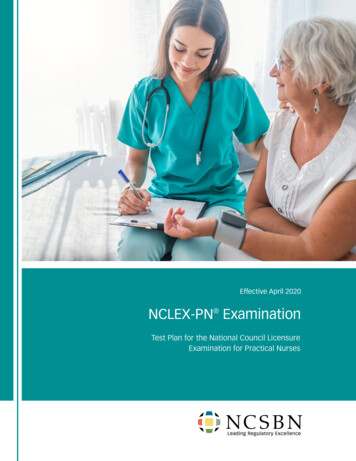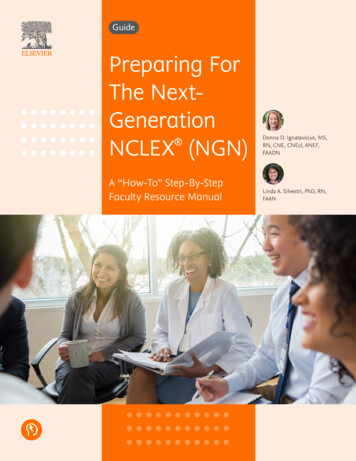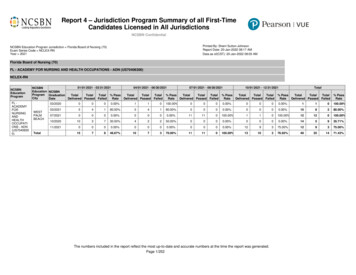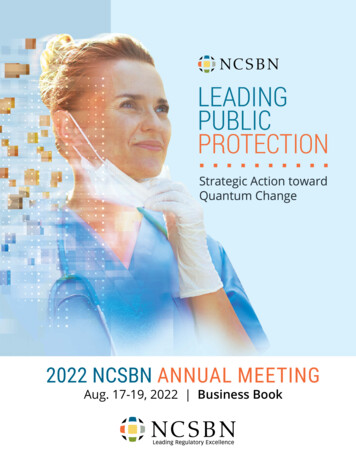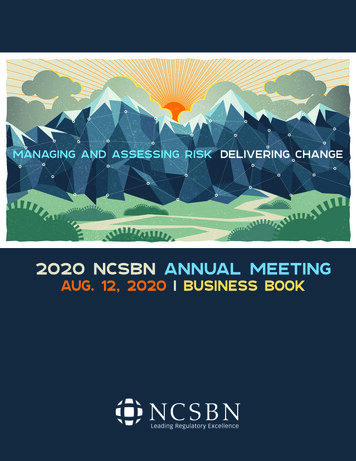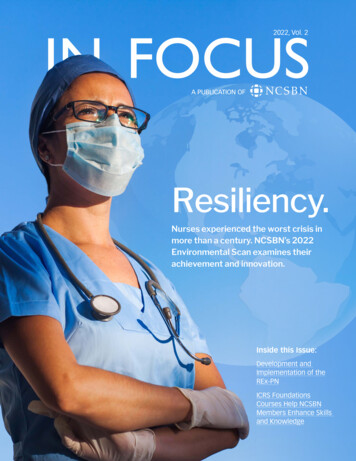
Transcription
2022, Vol. 2Resiliency.Nurses experienced the worst crisis inmore than a century. NCSBN’s 2022Environmental Scan examines theirachievement and innovation.Inside this Issue:Development andImplementation of theREx-PNICRS FoundationsCourses Help NCSBNMembers Enhance Skillsand Knowledge
2022, Vol. 2Managing Editor and WriterMichael Grossenbacher mgrossenbacher@ncsbn.orgIn This IssueContributing Editor and WriterDawn Kappel dkappel@ncsbn.orgAn Incredible Exam Experience. 4Kalona Owens kowens@ncsbn.orgBritish Columbia College of Nurses and Midwivesand College of Nurses of Ontario Collaborate withNCSBN to Develop and Implement the REx-PNFounded March 15, 1978, as an independent not-for-profitorganization, NCSBN was initially created to lessen theburdens of state governments and bring together nursingregulatory bodies (NRBs) to act and counsel together onmatters of common interest. It has evolved into one of theleading voices of regulation across the world.“This Proved Invaluable”. 8ICRS Foundations of Regulation Courses HelpNCSBN Members Enhance Skills and KnowledgeNCSBN’s membership is comprised of the NRBs in the 50states, the District of Columbia, and four U.S. territories —American Samoa, Guam, Northern Mariana Islands and theVirgin Islands. There are three exam user members. Thereare also 27 associate members that are either NRBs orempowered regulatory authorities from other countries orterritories.Resiliency. 12NCSBN’s 2022 Environmental Scan ExaminesNurses’ Achievement and InnovationDesigner12Mission: NCSBN empowers and supports nursing regulators intheir mandate to protect the public.The statements and opinions expressed are those of NCSBNand not the individual member state or territorial boards ofnursing.Copyright 2022 National Council of State Boards of Nursing,Inc. (NCSBN) All rights reserved. This document may not beused, reproduced or disseminated to any third party withoutwritten permission from NCSBN.News & Notes. 24Speed Round. 23Address inquiries in writing to NCSBN Permissions,111 E. Wacker Drive, Suite 2900, Chicago, IL 60601-4277.312.525.3600 www.ncsbn.org infocus@ncsbn.org482022, Vol. 2 3
An Incredible Exam ExperienceBritish Columbia College of Nurses and Midwives andCollege of Nurses of Ontario Collaborate with NCSBN toDevelop and Implement the REx-PNUntil recently, candidates for licensureas practical nurses in British Columbia orOntario sat for the Canadian Practical NurseRegistration Exam (CPRNE). Beginning in2022 however, these candidates beganwriting a new exam, developed by NCSBN forthe British Columbia College of Nurses andMidwives (BCCNM) and the College of Nursesof Ontario (CNO) — the Regulatory ExamPractical Nurse, or REx-PN for short.queue for modernization.We really wanted the bestin class. NCSBN is the goldstandard for regulatory exams-- the whole approach ofthe research, the evidence,pushing the evidence, movingto understand the issues oftoday and develop a productthat is fit for purpose.”The journey to the REx-PN began in2017, when BCCNM and CNO reviewedevidence related to the development andadministration of a new high-stakes entryexam for practical nurses.“When we look at the pacewith which health care ischanging and evolving, andthe competencies nursesmust bring to respond to theneeds in the system, CNO andTimmingsBCCNM wanted to ensurewe had a rigorous, state-ofthe-art exam,” says CNOChief Quality Officer CarolTimmings, MEd, BNSc, RN. “The two provinceshave a very high volume of exam applicants. Ifyou were to look at all of the nurses registeredin Canada every year, Ontario is the largest,followed very closely by British Columbia.Given our public safety mandate, we neededto feel confident the exam was assessingsafety and competency in exam candidates.That, in essence, is what prompted us to beginto look at the possibility of developing a newregulatory exam.”“The catalyst was that we needed tomodernize our exams in Canada,”explains BCCNM Chief Officerof Regulatory Policy &Programs ChristinePenney, PhD, MPA, RN.“We started withthe NCLEX , andthe practicalnurse examwas nextin thePenneycontinued on page 64 In Focus2022, Vol. 2 5
continued from page 5The purpose of the REx-PN is to ensure patientsafety and public protection. Items are developedto assess entry-level nursing knowledge. REx-PNcontent is referenced using textbooks, journals,and websites, commonly used in nursing curriculato ensure content reflects what is taught ineducational programs. In addition, REx-PN itemsare reviewed by practicing nurses to determinewhether the content aligns with current practice.The exam’s content originated from data gatheredfrom nurses in British Columbia and Ontarioregarding the activities of entry-level nurses.Moving forward, volunteer panels will performongoing item reviews to ensure the exam is fairfor all candidates. NCSBN will monitor all REx-PNitems and perform statistical analysis to ensureeach item is free of potential bias. Every examadministered must also fall within the examinationspecifications. These processes ensure that theREx-PN exam is only testing nursing knowledge.“We launched in January of 2022, but we had donea lot of work in the years prior inpreparing for the exam, gettingitems written and reviewedand tested and available,”says NCSBN Senior Manager,Examinations, Nicole Williams,WilliamsMSN, RN.One of Williams’ responsibilities is oversight ofcontent development of the REx-PN, ensuring thatdata discovered in the exam’s Practice Analysisinforms the Test Plan, the blueprint for the exam.The goal is to identify the minimum knowledge,skills and abilities to practice entry-level practicalnursing. “We did a lot of event testing prior tomoving the exam forward,” she says. “When welaunched, it was seamless — it went off without ahitch.”Timmings was impressed with the level ofcollaboration in the development process. “Itwas an incredible exam experience, and I don’t6 In Focususe the word ‘incredible’ lightly,” she says. “We’rethe regulators; we don’t have the psychometricexpertise and the exam development knowledgethat NCSBN has, but we felt that we were reallyactive partners as regulators at the table.”Establishing roles on day one was crucial to theproject. “A key success factor was that, at the veryoutset, we took time to establish the governance— the clarity of roles, communication, and decisionmaking in this work that we were embarkingupon together,” explains Timmings. “Yes, we hadthe formality of a contract, but it felt more like aco-creation exercise. Whether it was planning thepractice analysis, the field testing of questions, orthe recruitment of Canadian nurses to populatepanels, it was all thoughtfully done.”Penney agrees. “We had a good projectmanagement structure that was clear about whowas doing what and the milestones we needed tomeet. We had a clear roadmap and the partnerscame together to sort through issues that arosein a very efficient, competent way. It was a greatexperience.”A common misconception exam candidates andeducators may have is that NCSBN produces allof the questions on a test. The item developmentprocess is a collaborative one. In developing theREx-PN, there were many touchpoints along theway with Canadian nurses, educators and otherstakeholders. While NCSBN’s Examinations staffprovides training and assists with fact-checking,the REx-PN is a product of the Canadian nursingcommunity.“We reached out to the stakeholders in Canada-- the educators, Indigenous nurses, all of thedifferent people essential to be representedon committees, stakeholder consultations andmeetings,” says Penney. “The process allowed thereal involvement of Canadian stakeholders. Whenyou do that, people feel that they have been part ofthe process, and that it is their content.”“It is truly Canadian,” says Timmings. “It was reallythat authentic engagement of us -- not only asregulators in British Columbia and Ontario -- butthe nurses that we would be regulating, or thegraduating nursing students who would be writingthis exam. The idea that from the very beginningwe had the opportunity to build relationships andunderstand each other’s roles. We have a largeFrench community in Ontario. It sets us a bit apartfrom British Columbia, but instead of that beingan ‘us not you’ situation, we built that step into thedevelopment process, because it was understoodthat the French language community is animportant stakeholder.”Canadian jurisdictions collaborating; this had thepotential to be quite complex. But instead, therewas the most amazing, productive relationshipbetween the groups, whether it was thecommunications person, one of our educationconsultants, the project leads that we each had. Sothat’s what I would say made it incredible, really.”The recently launched RExPN.com offers access toall the information and resources candidates needfor their REx-PN journey.In reflecting on this project, both Penney andTimmings agree that two words come to mind:evidence-informed and collaborative. The work todevelop and implement the exam is grounded inevidence. The result is an exam that is in the bestinterest of the public: an accurate assessment ofan individual’s ability to practice safely at entry intothe profession.The four-year project is an exemplar of effectivecollaboration. BCCNM and CNO engaged keystakeholders over the course of the project and,together with NCSBN, worked hard to meet theirneeds.There were bumps along the way. Penney explainsthat when the COVID-19 pandemic hit, in- personpanels and item field testing were cancelled. “Thatwas one of the pivots that needed to be addressed,and it all went quite seamlessly,” she recalls. “I thinkthere were a few challenges with getting all therepresentation at our end and getting faculty. Butagain, we worked through all of that, and in the end,it just went amazingly well.”“I would have to say that if we were to chart thisprocess – as they say, it takes a village.” SaysTimmings. “It’s a community, it truly felt like that.To say that it was merely an exam developmentprocess that resulted in a deliverable doesn’tdo it justice. We had NCSBN in the U.S. and twoExperience RExPN.com Now
““This Proved Invaluable”ICRS Foundations of Regulation Courses Help NCSBNMembers Enhance Skills and KnowledgeFormal academic programs offer little instructionabout regulation. As a result, regulators havealways acquired much of their knowledge on thejob and through mentoring.Launched in 2019, NCSBN’s International Centerfor Regulatory Scholarship was born out of aneffort to explore ways to develop leaders innursing and health professional regulation. Thiseducational initiative offers online and blendedcourses designed to cultivate and elevate nursingleaders and policymakers around the world. It alsoprovides unprecedented opportunities for globalnetworking and collaboration. Courses are free ofcharge to all NCSBN members, associate membersand exam user members. Registration is also opento nonmembers for a fee.ICRS courses, taught by accomplished leaders andscholars, are an innovative way for professionals tolearn, network and collaborate. Course categoriesinclude:1. Foundations of Regulation2. Continuing Education3. ICRS Certificate ProgramFoundations of Regulation CoursesThe Foundations of Regulation courses aredesigned for new staff and board members whohave recently joined a nursing regulatory body,professionals who are interested in serving onboards and committees, and others looking toenhance their regulatory skills and knowledge.Each self-paced course can be completed in oneday, and each offers continuing education (CE)credits.Barbara Blozen, EdD, MA, RN-BC,CNL, president, New Jersey Boardof Nursing, has taken nine ICRScourses, including two Foundationsof Regulation courses.Blozen“The availability of the ICRSprogram, and the fact that it was online wasappealing,” she explains. “The time commitmentvaried for each course, and how much time youneed to devote could be related to your familiaritywith the topic or assignment. In general, I felt thetime commitment was appropriate.”— Barbara BlozenBlozen says she learned the finer details ofconducting a literature search in the Conductinga Literature Review course, and that courseinstructor — NCSBN Research Director BrendanMartin, PhD — prepared assignments that builton one another, leading up to a comprehensiveliterature review. “The course went step-bystep in teaching the mechanics of thoroughlyreviewing the literature,” she recalls. “I would highlyrecommend this course.”Blozen also took Parliamentary Procedurefor Nursing Regulators, taught by nationallyknown expert Leonard Young, EdD, MS, PRP,a professional registered parliamentarian. “Aspresident of my board of nursing, I found thiscourse helpful in organizing and conducting aproductive meeting,” she says. “The rules oforder provide one with standards for facilitating acontinued on page 108 In FocusThe Foundations courseswere extremely helpfulin my regulatory role.In a number ofsituations, I havebeen able todirectly applywhat I learned.International Center forRegulatory Scholarship2022, Vol. 2 9
continued from page 8discussion and group decision making. These rulesgive the meeting structure and provide everyonewith an opportunity to speak. Taking what I havelearned from this course has helped me to runmeetings in a more efficient and professionalmanner.”Asked how helpful the courses were overall, Blozensays, “The Foundations courses were extremelyhelpful in my regulatory role. In a number ofsituations, I have been able to directly apply whatI learned. The courses validated the work thatI do and informed my regulatory work. I wouldrecommend the ICRS program to colleagues andhighly recommend that board members take someof the courses.”JonesBrandon Jones, MSN, RN, CEN,NEA-BC, began his term aspresident of the Virginia Boardof Nursing in January 2022. Hesays that while he was excitedfor this new role, he was also a bitintimidated.“Despite routinely leading teams and meetingsin my full-time job and gaining experience asa board member over the last two years, theresponsibilities of board president created someunique learning opportunities,” he explains. “Ibegan searching for resources well before my termbegan, and to my surprise and joy, an email camein early December 2021 from NCSBN with the title,‘Enroll Now.’”Jones echoes Blozen’s praise for the ParliamentaryProcedure for Nursing Regulators course. “Itis a crash course in Robert’s Rules of Order. Itprepares those presiding over a meeting and thoseattending a board meeting to understand the rules,voting and various motions. It aided me in ensuringmy instructions to fellow board members wereclear and that everyone had a voice, ultimatelyhelping the meeting run efficiently and fairly.”10 In FocusPrinciples of Nursing Board Governance, taught byformer Idaho Board of Nursing Executive DirectorSandy Evans, MAEd, RN, provided Jones withuseful information on the concepts of governanceand regulation as they apply to nursing regulatorybodies. “Information about the current trendsand issues impacting nursing governance wasparticularly intriguing,” he says.And Role of the Regulatory Board Member, taughtby NCSBN Director of Leadership CapacityDevelopment and Member Engagement JimCleghorn, MA, “explored the board member’s roleand discussed the authority and responsibilities ofthe board of nursing,” says Jones. “A noteworthypart of this course was hearing directly from boardmembers and learning what helped them in theirregulatory journeys.”Throughout the Virginia Board of Nursing’s mostrecent proceedings, Jones says he used elementsof each ICRS Foundations course. “This provedinvaluable as I chaired my first formal hearingsand business meeting. These self-paced coursesmet many of the needs I identified to help megrow as board president and board member. I amthankful for the many free educational offeringsprovided by ICRS and I hope to explore otherPROGRAM HIGHLIGHTS:topics in the future. To my fellow board members,ChoosesixoncoursesI will encourage you with the exactwordstheemail that helped me discoverNow!’knowledge ICRS:Gain ‘EnrolladvancedEnrolling in any ICRS course willstrengthenyourEnhanceleadershipskillsknowledge of nursing regulation, provide practical Build a network of colleaguesapplication and positively impact the public we arecharged with safeguarding.” Expert instructors Continuing education creditsfor eligible professionalsLEARN.NETWORK.LEAD.NCSBN’s International Center forRegulatory Scholarship (ICRS)provides unprecedentedopportunities for nursing and policyleaders from around the world toNCSBN’s International Center forICRS CERTIFICATEPROGRAMRegulatory Scholarship(ICRS)learn,interact and collaborate.provides unprecedentedOur online and blended course of study is designed to cultivate and elevateleaders andof state,national and international regulatory bodies.opportunities for nursingpolicyleaders from around the world toThis two-year program is competency-based and provides specializedlearn, interact andeducationcollaborate.on topics unique to health care regulation along three pathways:PROGRAM Governance and Leadership Public Policy and Legislation Research and MeasurementHIGHLIGHTS: Choose six courses Gain advanced knowledge Enhance leadership skills Build a network of colleagues Expert instructorsVideoPlay PlayVideo Continuing education creditsfor eligible professionalsPROGRAM HIGHLIGHTS: Choice of six courses Gain advanced knowledge Enhance leadership skillsVideoPlay PlayVideo Build a network of colleagues Expert instructors Continuing education credits for eligible professionalsCourses are currently open for enrollment to all Free of charge to all NCSBN Free of charge to all NCSBN Free of charge to all NCSBN Members,regulatory, nursing and policy leaders around theMembers, Associate Members and Exam User MembersAssociateand Exam User MembersMembers, Associate Members and ExamUserMembersMembersworld. Access to ICRS courses is free of chargeLeadershipInstitute in-person event and graduation ceremony Advancedto all NCSBN Members, AssociateMembersand Advanced Leadership InstituteAdvancedLeadershipInstitutein-personevent and graduation ceremony Exam User Members. Contact ICRS for questionsin-person event and graduation ceremonyconcerning the courses, refunds and/or tuitionLearn MoreApply Todayicrsncsbn.orgassistance.Learn MoreLearnmoreicrsncsbn.orgApplyTodayicrsncsbn.org
Resiliency.Nurses experienced the worst crisis in more than a century. NCSBN’s2022 Environmental Scan examines their achievement and innovation.No occurrence in the past 100 years, with the possible exception of theSecond World War, has had a greater global impact than the COVID-19pandemic. While every facet of society was touched in some way, no othersector was impacted the way health care was, and nursing took the brunt ofthe cataclysm.Every year the NCSBN Journal of Nursing Regulation (JNR) produces a comprehensiveoverview of the health care landscape with a specific focus on nursing and regulation. The2022 Environmental Scan, just published as a special free supplement to JNR’s Januaryedition, tells the story of “resiliency, achievement and public protection.”Scanning the health care environment is a daunting undertaking at the best of times,but that task becomes exponentially harder during an ongoing pandemic. The 2021Environmental Scan details the profound effects of the pandemic, and while the 2022edition looks at the continuing influence of COVID-19 on the nursing workforce, nursingeducation, health care delivery and legislation and policy, it also examines recent eventsand emerging trends.AlexanderJNR Editor-in-Chief, Maryann Alexander, PhD, RN, FAAN, NCSBN ChiefOfficer, Nursing Regulation, notes, “Despite all that has happened tochange the world since 2020, the underlying message of this year’senvironmental scan is resilience. The nursing workforce, educators, andregulators have experienced the worst health care crisis in more than acentury, and yet, our report is marked by achievement and innovation.”continued on page 142022, Vol. 2 13
International and U.S. Nurse WorkforceThe International Council of Nurses estimatesthat due to existing nursing shortages, theaging of the nursing workforce and the growingCOVID-19 effect (heavy workloads, insufficientresourcing, burnout and stress), 10.6 millionnurses will need to be added to the globalworkforce by 2030 to fill the global nurseshortage gap.The U.S. is also facing a looming nursingshortage. NCSBN’s National Nursing Databasetracks the number of U.S. licensed nurses from57 boards of nursing (BONs) and is updateddaily (excluding Michigan). As of Sept. 30, 2021,there were 4,317,277 registered nurses (RNs)and 918,919 licensed practical/vocationalnurses (LPNs/VNs) in the U.S. The most recentOccupational Employment Statistics data fromMay 2020 indicate that 2,986,510 RNs and676,460 LPN/LVNs were employed in the U.S.(U.S. Bureau of Labor Statistics [BLS], 2021a).Since 2012, NCSBN and the National Forumof State Nursing Workforce Centers haveconducted a biennial National NursingWorkforce Survey. These surveys draw anationally representative sample of more than5 million RNs and LPNs/LVNs currently licensedin the U.S. An alarming trend from the 2020Survey revealed that one-fifth of nurses whoresponded plan to retire or leave the professionover the next five years. The survey foundthat the median age of RNs was 52 years. Themedian age of the workforce has remainedapproximately the same since 2013, but theage distribution of the workforce has changedsubstantially. Nurses who are aged 65 years orolder account for 19% of the RN workforce andcomprise the largest age category.14 In FocusThis potential exodus of 20% of the nursingworkforce has serious implications for thecare of an aging population plagued by chronicdiseases and comorbidities. Along with nurseretirement, nurses leaving practice and an agingpopulation, there are not enough new nursesentering the health care system to meet thedemand.COVID-19 Impact on Nursing EducationCompared with the turmoil in 2020 thatoccurred during the shutdowns andsubsequent inability of schools to provideclinical experiences for nursing students, 2021represented a shift toward normalcy. However,the reverberations of the pandemic on nursingeducation may be felt for years.Throughout the pandemic, U.S. nursingstudents have expressed concerns aboutlacking in-person clinical experiences and theirdifficult adjustment to online learning. Theseconcerns have carried over into apprehensionsabout passing the NCLEX Examination andpreparedness for practice.The Future of Nursing 2020–2030: Charting aPath to Health Equity noted that the pandemiccalled attention to “deficiencies in the nursingworkforce’s preparedness to respond to publichealth emergencies and other disasters.” Thepublication identified nursing education as onemeans of addressing these deficits. (NationalAcademies of Science, Engineering andMedicine, 2021).However, the deficiency is multilayeredoccurring not only in the nursing curriculum,but “also in the infrastructure of programsthemselves.” Michel et al. (2021), Nursingprograms are ill-equipped to be able to pivotquickly and efficiently, as demonstrated by the“haphazard movement to remote teaching andthe abrupt removal of students from clinicalfacilities.” The publication suggests that “thatfuture planning should address how disastersmay affect students, their clinical experiences,collaborative agreements, and regulatoryrequirements.”In 2020, nursing leaders led by NCSBN calledfor the creation of the practice-academicpartnership model. The implementation of suchpartnerships and their ongoing success meantthe model could be applied to meet the enduringchallenges nursing education programs face insecuring clinical sites, even in the absence of aglobal or national public health emergency.Nancy Spector, PhD, RN,FAAN, director of RegulatoryInnovations at NCSBN,remarked, “One silver liningis that the pandemic openedSpectordoors of cooperation betweenacademia and practice, creating modelpartnerships that offer clinical educationopportunities for students in places where suchopportunities are scarce, so that students gaininvaluable experiences with patients in real worldsettings.”In the wake of clinical site closures during thepandemic, many educational programs sought tosubstitute clinical experiences with simulation.This created another dilemma because in manycases nursing classes were being conductedvirtually and simulation labs required in-personparticipation. Some schools turned to providingvirtual simulation as a replacement whereby,continued on page 162022, Vol. 2 15
continued from page 15The shortage of LPNs/VNs is also a trend thatbears watching. In 2020, “for the first time in10 years, BSN programs had more NCLEX-RNtest takers than ADN programs. In contrast,2020 brought the lowest number of NCLEX-PNtest takers in 10 years.” This may have severeimplications for skilled nursing facilities.Health Care DeliveryNCSBN’s landmark simulation study, whichprovided evidence that “simulation can besubstituted for up to 50% of traditional clinicalexperiences with no significant difference inoutcome, used a 1:1 ratio of clinical experiencehours to simulation hours,” more study is neededto determine whether virtual simulation cansubstitute for clinical simulation hours.In 2020, NCSBN launched a research study toinvestigate the effect of rapid changes made innursing education programs in response to theCOVID-19 pandemic. The “National PrelicensureRN Study: Assessing the Impact of COVID-19on Nursing Education” is currently underwayat 55 nursing education sites across 26 U.S.states. The study seeks to determine the extentto which programs changed their instructionalformats due to the COVID-19 pandemic. Thestudy will then prospectively and longitudinallytrack over 700 prelicensure nursing students16 In Focusand 450 faculty to measure engagement,academic performance and early careerexperience. The study will conclude in 2022.Principal investigator BrendanMartin, PhD, director, NCSBNResearch, comments, “Thekey strengths of this studyare its ability to track studentMartinperformance in real-time duringthe COVID-19 pandemic and, from a regulatorystandpoint, its focus on how well theseexperiences prepare new graduates for theirtransition to early career professionals.”Another challenge facing nursing education isthe growing shortage of faculty. Although thenumber of individuals interested in pursuingnursing as a career is increasing, facultyvacancies may limit the number of students thatcan be enrolled.During the pandemic, entrenched weaknessesin the U.S. health system were exposed andmagnified. These shortcomings include“vulnerability of long-term care facilities, thefinancial instability of rural and public hospitals,outdated technical infrastructure, preexistingbaseline supply and medication shortages, anddisparities in health quality and outcomes acrossracial and ethnic groups (Assistant Secretaryfor Preparedness and Response TechnicalResources, Assistance Center, and InformationExchange [ASPR TRACIE], 2021).”In response to the COVID-19 pandemic, stateand federal legislation sought to put in placeemergency waivers to meet the demand fornurses across the country. These waiversincluded the issuance of emergency licensesand the increased use of telehealth services.States also issued emergency waivers andprovisions that waived collaborative agreementrequirements for advanced practice registerednurses (APRNs). Many of these emergencymeasures have expired or are set to do so in thenear future.The Future of Nursing report offered lengthydiscourse about the future of APRN practiceand most notedly called for removing barriersto APRN full practice authority. Acknowledgingthe correlation between poor health outcomesin underserved communities and restrictionson APRN practice, the report “predicts theimportance of APRNs practicing to the fullscope of their education without restriction,especially in areas such as opioid treatmentand the provision of primary care in light of thecontinuing primary care physician shortage.”Many states instituted waivers in 2020 thatimpacted APRN licensure and regulation. Butdespite rising caseloads caused by the omicronvariant, many states had either rescinded or lettheir emergency declarations expire by the fall of2021.Nurse Licensure Compact (NLC) and theAdvanced Practice Registered Nurse(APRN) CompactThe Future of Nursing Report also called for thenationwide adoption of licensure compacts.The NLC added three states and two territoriesto its list of members in 2021, bringing the totalmembership to 39. Ohio, Pennsylvania, andVermont are the newest states to join the NLC.Guam and the U.S. Virgin Islands became thefirst and second U.S. territories.Both North Dakota and Delaware enacted theAPRN Compact in 2021. Increasing mobility,access and health care equity, the APRNCompact allows APRNs to practice freely amongmember states while still allowing each state toretain autonomy and the authority to enforceits nurse practice act. The compact eliminatesredundant, duplicative regulatory processes andunnecessary fees while increasing access tocare. The APRN Compact will be implementedwhen seven states have enacted the legislation.continued on page 182022, Vol. 2 17
continued from page 17COVID-19 and Opioid Morbidityand MortalityAs the U.S. experienced a dramatic increasein deaths due to COVID-19, there was also asignificant increase in drug overdose deaths.Experts theorize this increase may be due toseveral factors, including the disruption toa
French community in Ontario. It sets us a bit apart from British Columbia, but instead of that being . learn, network and collaborate. Course categories include: 1. Foundations of Regulation 2. Continuing Education . 19-healthcare-delivery-impacts.pdf Comprehensive Addiction and Recovery Act of 2016, S.B. 524, 114th Cong. (2016). https .
